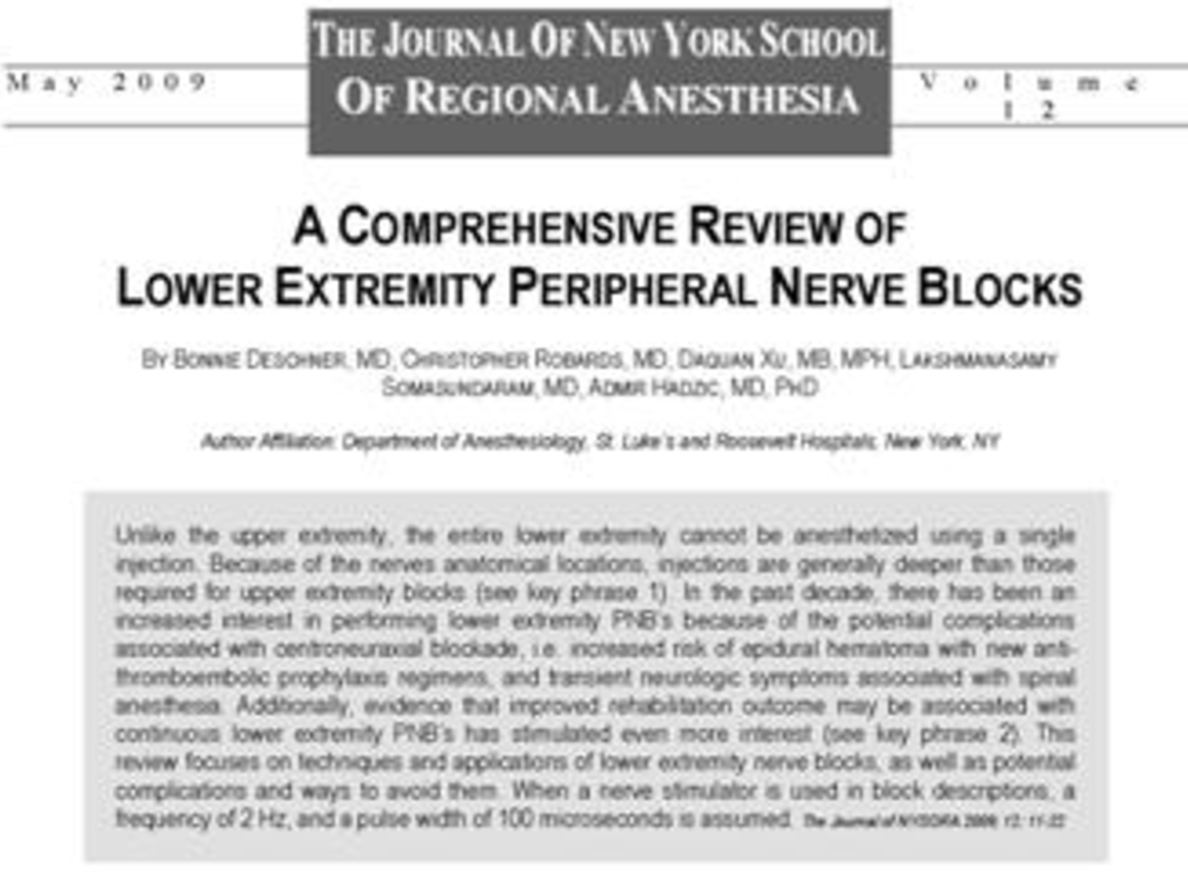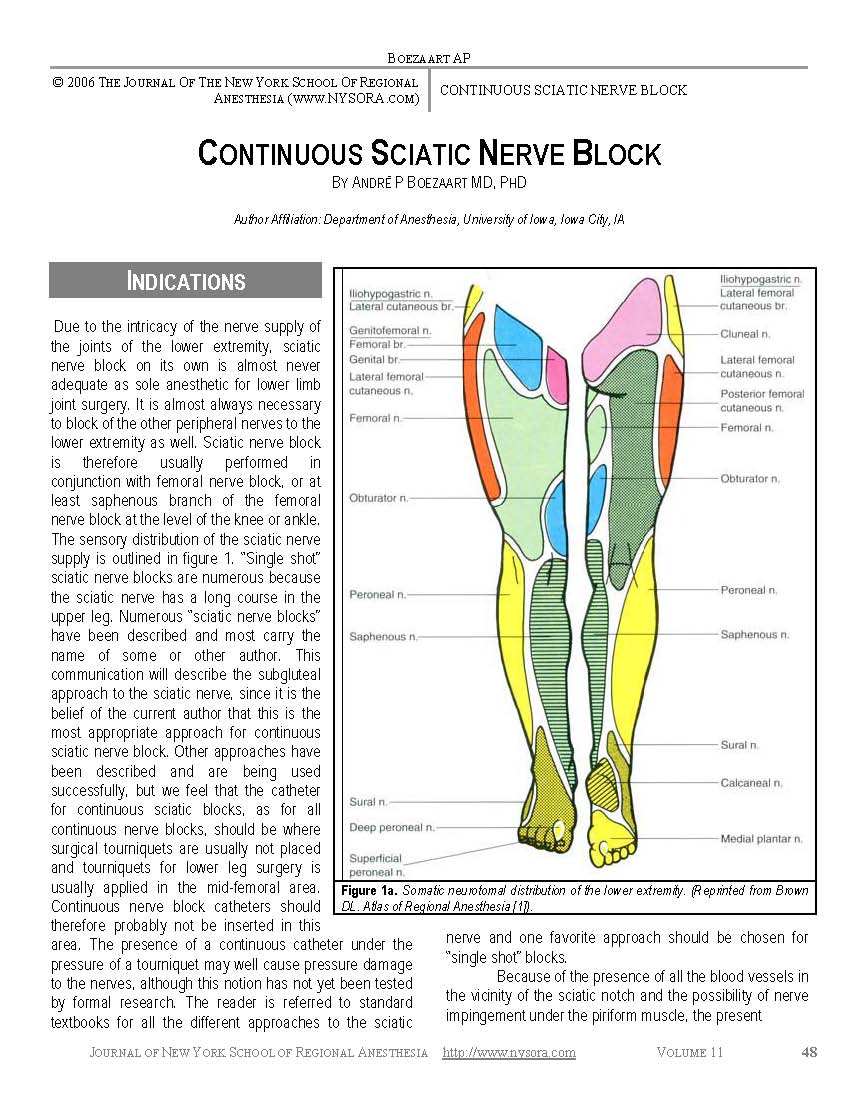JNYSORA Volume 10 March 2009
The results of this survey point out that the American Society of Regional Anesthesia (ASRA) and its membership are significant promoters of the regional anesthesia and peripheral nerve blocks.
Based on: “Hadzic A, Vloka JD, Kuroda MM, Koorn R, Birnbach DJ. The use of peripheral nerve blocks in anesthesia practice. A national survey. Reg Anesth Pain Med 1998:23:241-246”.
|
In an attempt to ascertain clinical practice paterns and use of peripheral nerve blocks, we surveyed 805 randomly selected U.S. anesthesiologists.[1] Responses from 409 attending anesthesiologists (response rate 56.5%) revealed that while almost all of them (97.8%) regularly use at least some regional anesthesia techniques in their practice, significantly fewer use peripheral nerve blocks. Most anesthesiologists (59.7%) perform less than five peripheral nerve blocks a month. Peripheral nerve blocks of the lower extremity (femoral 32%, sciatic 22%, popliteal 11%) were less frequently used than peripheral nerve blocks of the upper extremity (axillary 88%, interscalene 61%; p<0.001). Anesthesiologists who rated their training in peripheral nerve blocks as adequate (50.8%) devoted more time in their practice to peripheral nerve blocks than anesthesiologists who rated their training as inadequate (p=0.02). Respondents predicted that their use of peripheral nerve blocks would increase in the future (Figure 1).  Figure 1: Horizontal bars represent percentages of anesthesiologists who reported performing the indicated anesthesia techniques in their practice. * Hadzic A, Vloka JD et al. The use of peripheral nerve blocks in anesthesia practice. A national survey. Regional Anesthesia, 1998. Despite a commonly voiced perception that peripheral nerve blocks are practiced more on the West Coast than in the Mid-West or the East Coast, our comparison did not find any significant differences between the various regions of the U.S. A majority of anesthesiologists reported using spinal and epidural anesthesia in their ambulatory anesthesia practice (Figure 2), despite potential disadvantages of neuraxial techniques in the outpatient setting (e.g., risks of post-dural puncture headache, backache, or postural hypotension). Although specific lower extremity peripheral nerve blocks offer many potential advantages over neuraxial anesthesia in ambulatory patients [2,3], a majority of anesthesiologists who provide anesthesia in ambulatory settings do not use peripheral nerve blocks for lower extremity operations. This infrequent use of peripheral nerve blocks could be partly explained by inadequate exposure to peripheral nerve block techniques during anesthesia residency training (as reported by almost half of the respondents). This, however, does not explain why those who practice various peripheral nerve blocks use them less frequently in outpatients. The routine use of peripheral nerve blocks could be hindered by a lack of familiarity by surgeons of the benefits of peripheral nerve blocks, time pressure, rapid turnover of cases, as well as logistical impediments in the ambulatory setting.  Figure 2: Horizontal bars represent percentage of anesthesiologists who use the technique in their ambulatory anesthesia practice. * Hadzic A, Vloka JD, Koorn R, Sanborn K, Shih H, Birnbach DJ. The use of regional anesthesia in ambulatory anesthesia practice. Results of a national survey. Anesthesiology 1997; 3A:A22. The results of this survey point out that the American Society of Regional Anesthesia (ASRA) and its membership are significant promoters of the regional anesthesia and peripheral nerve blocks. This is clearly reflected in the fact that the members of ASRA not only practice significantly more peripheral nerve blocks than anesthesiologists who are not ASRA members, but they also perform technically more challenging peripheral nerve blocks (e.g. lower extremity blocks). Another indirect indication of their enthusiasm for regional anesthesia is reflected in their overall high response rate to this survey. Of note, despite the apparent underutilization of lower extremity peripheral nerve blocks, many practitioners expected that peripheral nerve blocks will have an increased role in their clinical practice in the future. Since the infrequent use of peripheral nerve blocks makes it difficult to achieve time-efficient proficiency in these techniques in a fast-paced environment, it is important that organized anesthesia societies, such as ASA, ASRA, and SAMBA continue to offer hands-on regional anesthesia workshops as well as symposia that also focus on less frequently used PNB techniques. Finally, education of our patients and surgical colleagues as to the advantages of peripheral nerve blocks, and elimination of all logistical problems that impede the easy placement of regional blocks and patient flow are equally important. REFERENCES: 1. Hadzic A,Vloka JD, Kuroda MM, Koorn R, Birnbach DJ. The use of peripheral nerve blocks in anesthesia practice. A national survey. Reg Anesth Pain Med 1998:23:241-246. 2. Vloka JD, Hadzic A, Mulcare R, Lesser JB, Kitain E, Thys DM. Femoral nerve block versus spinal anesthesia for outpatients undergoing long saphenous vein stripping surgery. Anesth Analg,1997;84:749-52. 3. Vloka JD, Hadzic A, Mulcare R, Lesser JB, Koorn R, Thys DM. Combined blocks of the sciatic nerve at the popliteal fossa and posterior cutaneous nerve of the thigh for short saphenous vein stripping in outpatients: An alternative to spinal anesthesia. J Clin Anesth 1997;9:618-22. |






